USDTL Research
On The Level: Screening and Confirmation Testing Explained
Preliminary testing (i.e. initial testing, screening), confirmation, and cutoff levels are some of the complexities of drug testing that can often be misunderstood by those outside of the laboratory setting. To shed more light on the topic, we wanted to break down the steps of our testing and explain how they correspond to the results we send out to our customers.
To begin, it is important to understand the difference between drug classes, and drugs, including drug metabolites. Drug classes are the overarching groups under which individual drugs similar in nature are categorized, and thus are the basis of how our drug testing panels are classified (i.e. amphetamines, cannabinoids, opiates, etc.) (Figure 1).
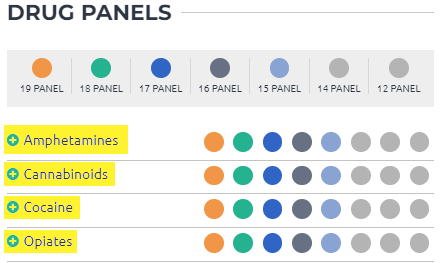
Figure 1
Within a drug class, there are drugs and their metabolites (formed when a drug is metabolized by the body). We test for specific drugs and/or drug metabolites that are most useful in implying ingestion or exposure of substances of abuse. For example, there are many different substances that fall under the amphetamine drug class, but we only test for amphetamine, MDA, MDEA, MDMA, and methamphetamine
(Figure 2). The same is true for cannabinoids, with well over 100 individual compounds that can be categorized under that drug class. The main pharmacologically active ingredient of the cannabis plant is tetrahydrocannabinol (THC), so our testing looks only for THC, or the drug metabolite Carboxy THC.
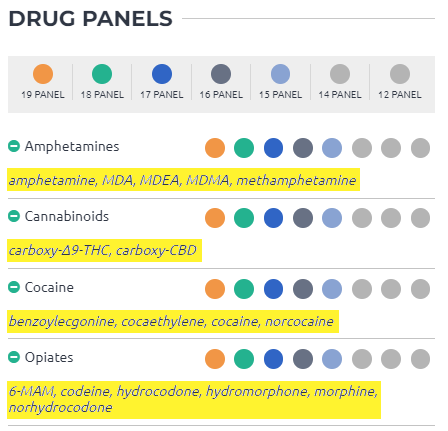
Figure 2
Initial Testing and Results
Screening is the process of sending all specimens through highly sensitive instrumentation that is quick and effective for determining whether a specimen might contain substances of interest. The screening process cumulatively tests for many compounds that fall within the given drug classes. The drug classes screened are determined by the drug panels selected by the client for testing.
If a specimen runs through the screening process and nothing is detected, our Negative Certifying Scientists verify the negative results and the negative report is sent out. This is why the negative results generally have a quick turnaround time.
If a specimen runs through the screening process and something is detected, it means we need to take a closer look to see what it is, but it does not mean that it has tested positive for any specific drug or drug metabolite yet. It just means the specimen did not test negative when it was tested for many different compounds. At this point, the specimen must go into confirmation testing.
Confirmation Testing and Results
As an accredited forensic toxicology laboratory, we are required to confirm all results that we report out as positive. To perform confirmation testing, another portion from the original specimen is analyzed by a more advanced and specific instrument, but this time, due to the screening results, we have an idea of what we need to look for and what drugs to consider. Confirmation testing takes longer to complete than screening because the instrument is looking for individual drugs and drug metabolites. Confirming positive results can take up to 24-48 additional hours after the screening results have been completed.
To perform confirmation testing, another portion from the original specimen is analyszed by a more advanced instrument, but this time, due to the screening results, we have an idea of what we need to look for and what drugs we need to consider.
Cutoff Levels
Cutoff levels are the detection thresholds for compounds that are set on the testing instrumentation.
To use the cannabinoid example, our screening cutoff level for the cannabinoid drug class in a hair specimen is 1 pg/mg. If any of the hundreds of cannabinoids cumulatively register above this cutoff level, the specimen would go into confirmation testing. As mentioned previously, our confirmation instrumentation is only looking for one of two specific drug/drug metabolites that are of interest when it comes to drug testing for cannabis ingestion or exposure, Carboxy THC (ingestion) and/or THC (exposure). Any other cannabinoids that might have contributed to reaching the screening cutoff levels are not tested for during confirmation since they are not currently considered relevant to detecting cannabis ingestion or exposure.
Screening and confirmation cutoff levels often cause confusion when it comes to testing results. We are frequently asked how a regular hair drug test can confirm positive for Carboxy THC at, let’s say 0.15 pg/mg, when the screening cutoff is well over that limit at 1 pg/mg. The answer is that the screening and confirmation tests are completely different tests, using different instruments, looking at different things. The screening cutoff levels were reached with multiple cannabinoids being tested that registered above the screening test cutoff level (1 pg/mg). When the specimen went into separate confirmation testing (an entirely different test from start to finish) only Carboxy THC was being measured, with different cutoff levels (0.05 pg/mg). This means that, of all the cannabinoids that registered in the specimen, there was only 0.15 pg/mg of Carboxy THC in the specimen.
When using the cannabis example specific to hair testing, it is important to note that we have two distinctive tests for detecting THC in a hair specimen. Though the screening process for both tests are the same, the test preparation and confirmation processes differ. Figures 3-6 illustrate the difference of THC detection between the two tests.
1.
Hair Drug Test: This drug test is most frequently used when drug testing adults for cannabis use (ingestion). The confirmation instrument for this test is looking for Carboxy THC, the drug metabolite of THC. Presence of Carboxy THC indicates ingestion because it is only found if the body has metabolized THC.
2.
Hair Exposure Test (ChildGuard®): Hair has a porous surface so substances from the environment tend to stick to it, making exposure testing possible. This test is most often used for minors, or those under legal guardianship, when their environments are thought to be unsafe due to substance exposure. This is testing for ingestion and exposure and therefore the confirmation test is looking for both Carboxy THC and THC. This is a special test because, unlike the regular hair drug test, the exposure test will report a confirmed positive if THC or Carboxy THC, or both are present in the specimen. This is the only hair drug test that can test for passive drug exposure without the need for ingestion. It is beneficial for donors who are being exposed to harmful environments, but may or may not be ingesting the substances themselves, though accidental ingestion can occur. Donors that tend to put their hands in their mouths frequently (younger, developmentally disabled, etc.) may accidentally ingest substance residue from their environment.
Figure 3 illustrates a screening test on a hair specimen for cannabinoid ingestion. You can see that there are numerous cannabinoids that are detected in the specimen that could result in a test needing a closer look with confirmation testing. The cumulative level of cannabinoid compounds detected (THC, Carboxy, other) would all contribute to reaching the cutoff level for screening (1 pg/mg). If the detectable amount of compounds in a specimen falls below the screening cutoff level, the specimen will be reviewed and verified by a Negative Certifying Scientist and reported out as a negative result.
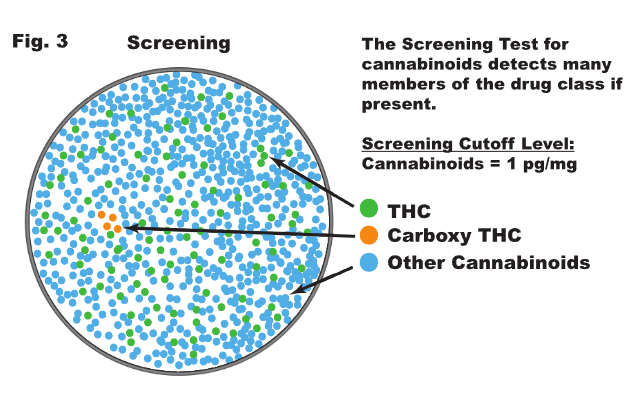
Figure 3
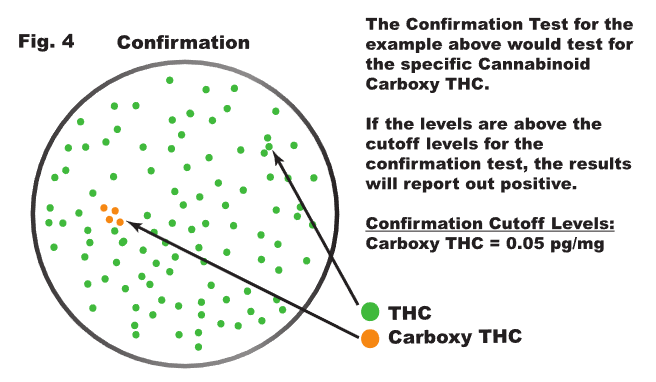
Figure 4
Figure 4 illustrates the confirmation test for ingestion that would follow the screening test from the specimen example in Figure 3 if the detectable amount of compounds in the cannabinoid drug class exceeded the screening cutoff level of 1 pg/mg. Since this is a confirmation test for ingestion it will be detecting the specific levels of the Carboxy THC only. If the levels exceed the Carboxy THC confirmation cutoff level (0.05 pg/mg), the results will be reviewed and verified by a Positive Certifying Scientist and then reported out as a confirmed positive results. If the levels of Carboxy THC do not exceed the confirmation cutoff levels, the results will be reviewed and verified by a Negative Certifying Scientist and reported out as a negative results.
Figure 5 is similar to Figure 3, but it is illustrating the screening of a specimen that would indicate environmental exposure, not ingestion. Even though there is a lack of Carboxy THC, the THC and other cannabinoids would contribute to the cumulative levels in the specimen.
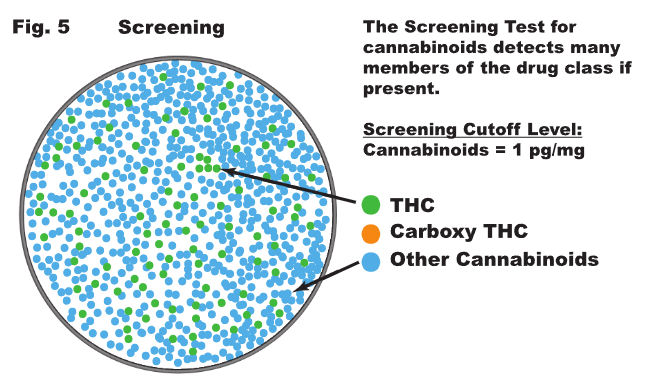
Figure 5
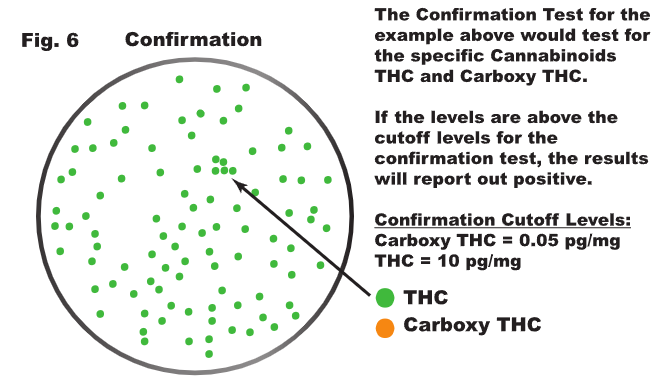
Figure 6
Figure 6 illustrates the confirmation test that would follow the screening test for THC exposure for the specimen example in Figure 5. Again, you will notice the lack of Carboxy THC in the specimen, this is because THC has not been metabolized by the donor, generally implying environmental exposure. The confirmation test for environmental exposure would also detect Carboxy THC if it is present.
To perform confirmation testing, another portion from the original specimen is analyzed by a more advanced instrument, but this time, due to the screening result, we have an idea of what we need to look for and what drugs we need to consider.
Screening and confirmation techniques, as well as the cutoff levels can vary from one specimen to another. We hope that having a better understanding of the significance of these elements and their functions within the drug testing realm can help broaden the overall knowledge of how different specimen tests and drug panels can be utilized to get the best results.
Choosing the Right Newborn Test
Contact USDTL
1.800.235.2367
Client Services
By Phone: 1.800.235.2367
Business Hours (CST)
Monday....................7am-7pm
Tuesday....................7am-7pm
Wednesday.............7am-7pm
Thursday..................7am-7pm
Friday........................7am-7pm
Saturday...................8am-5pm
Newsletters, Posters, and Catalogs
Our print materials will keep you up to date on the latest news in drug and alcohol testing.
Request Your Collection Supplies
For your convenience, USDTL provides test collection supplies at no additional charge.


